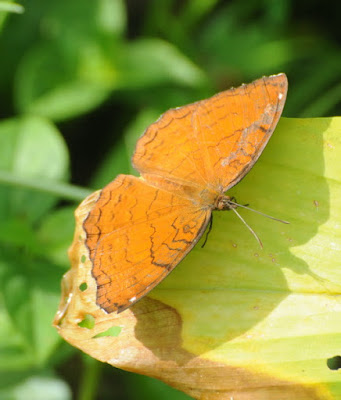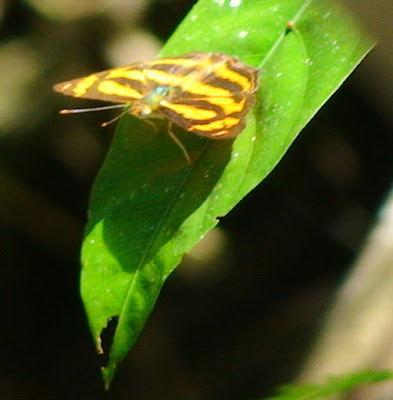From Australia Eileen and I finally returned to Sarawak, where we found ourselves caught up our usual round of friends and family. With the exception of a short trip to the beach resort at Damai (of which more in a later post), I did not have a chance to get out in the field again until April 28, 2011, when our old friend Lord Cranbrook, in Kuching on his annual visit, invited us to join him on an outing to a small cave in the limestone karst country on the road to Borneo Highlands.
We picked up a local Iban guide in a kampung near the cave site. He assured up that getting up to the cave would be no trouble at all. Well, it certainly was no trouble for him - but what was easy for a wiry little jungle hunter was quite a different matter for us (and particularly for an overweight, out-of-shape orang puteh such as Your Correspondent.
The first approach we tried to reach the cave involved scaling a steep, narrow rocky ledge in the forest, guided by a handrail that we were cautioned not to use, for fear it would give way.
Needless to say, we didn't get far. Lord Cranbrook, who had a cold, was feeling none to well, I was gasping for breath, Eileen was convinced that we were gong to break our necks, and our friend Daisy, who had unsuspectingly come along for the ride, had the wrong sort of footwear.
To at least my considerable relief, we gave up.
Undaunted (well, sort of undaunted), we tried again. This time, we got as far as a cleared patch of crops in the forest before deciding that it was too hot to go on (and Lord Cranbrook was feeling none too well). Instead, it was generally decided that only one of us should go on to the cave with our guide, and that the person elected to do so would be me. A trifle reluctantly, I agreed.
And so, I ended up struggling up the slope, among the rocks....
...to the cave opening.
More interesting than the cave itself (at least for me) were the rocks around the entrance, and the garden of plants that grew over them.
They included a bevy of ferns in a variety of sizes and shapes...
...a few peculiar-looking aroids...
...plants that I assumed to be gesneriads (that is, African Violet relatives)...
...a balsam (Impatiens sp.)...
...and a begonia, one of many in Malaysia...
Back on the forest floor, I found tiny fruiting bodies of fungi sprouting from the leaf litter.
Undaunted (well, sort of undaunted), we tried again. This time, we got as far as a cleared patch of crops in the forest before deciding that it was too hot to go on (and Lord Cranbrook was feeling none too well). Instead, it was generally decided that only one of us should go on to the cave with our guide, and that the person elected to do so would be me. A trifle reluctantly, I agreed.
And so, I ended up struggling up the slope, among the rocks....
...to the cave opening.
More interesting than the cave itself (at least for me) were the rocks around the entrance, and the garden of plants that grew over them.
They included a bevy of ferns in a variety of sizes and shapes...
...a few peculiar-looking aroids...
...plants that I assumed to be gesneriads (that is, African Violet relatives)...
...a balsam (Impatiens sp.)...
...and a begonia, one of many in Malaysia...
Back on the forest floor, I found tiny fruiting bodies of fungi sprouting from the leaf litter.
As we made our way out of the forest I was delighted to find quite a few dragonflies about. Along a tiny stream in the forest I found this male Trithemis festiva. The photo is a bit too dark to show clearly one of its distiguishing marks, a series of ochre patches on the upper side of the abdomen, but believe me, they're there.
When I first started assembling and labelling these photos, I confess I got many of the identifications wrong. I at first misidentified this one as Brachydiplax chalybea (hence the file name on the photograph), but it is much more likely to be Orthetrum glaucum.
This, despite the file label, is Urothemis signata; note the red eyes and wing venation.[July 2017: no, it's Trithemis aurora!].
Don't believe the file name on this one either: it is, I now think, Orthetrum chrysis.
Got this one wrong, too: it is Orthetrum testaceum, not Crocothemis servilia. For one thing, it has brown, not red, eyes; and for the technically minded, it has a complte antenodal crossvein. I'm better at these now because I have the very useful A Photographic Guide to the Dragonflies of Singapore by Tang Hung Bun et al., which covers a lot of the common Borneo dragons and has very helpful comparison pages on the red and blue libellulids, groups I find particularly confusing.
I'm on firmer ground here, at least to genus: this is certainly a Neurothemis, with those big swathes of colour across the wings. But which one? There are two likely candidates, N. fluctuans and N. ramburii. The chief difference, according to A.G. Orr's A Guide to the Dragonflies of Borneo, is size (which I can't use here) and that in the larger ramburii "typically there is only one crossvein in the cubital space of the hindwing (behind the median space)". Well, as far as I can see this one has two crossveins in the area behind the median space (the long veinless trip at the base of the hindwing), which means that this is probably a male Neurothemis fluctuans.
This one, with a bright red face and the clear area of the wing more squared off than in the dragonfly above, is probably Neurothemis terminata. Neurothemis spp. are abundant "ditch dragonflies" in Borneo, and I snapped both of these insects by the main road once we got back to the car.
On to butterflies: this is a member of the genus Ariadne, likely an Angled Castor (Ariadne pallidior).
This is a Grey Pansy (Junonia atlites)...
And this is a Common Lascar (Pantoporia hordonia).
A large and handsome millipede scales a tree trunk...
While a rhinoceros beetle - possibly the Asian Rhinoceros Beetle (Oryctes rhinoceros) - has blundered into a mist net set up to protect the crop field. O. rhinoceros is a pest on oil palm, and given my opinion of that plant I risk being one of its firm admirers in consequence...
This is a Grey Pansy (Junonia atlites)...
And this is a Common Lascar (Pantoporia hordonia).
A large and handsome millipede scales a tree trunk...
While a rhinoceros beetle - possibly the Asian Rhinoceros Beetle (Oryctes rhinoceros) - has blundered into a mist net set up to protect the crop field. O. rhinoceros is a pest on oil palm, and given my opinion of that plant I risk being one of its firm admirers in consequence...




































No comments:
Post a Comment